Cooking Up Math
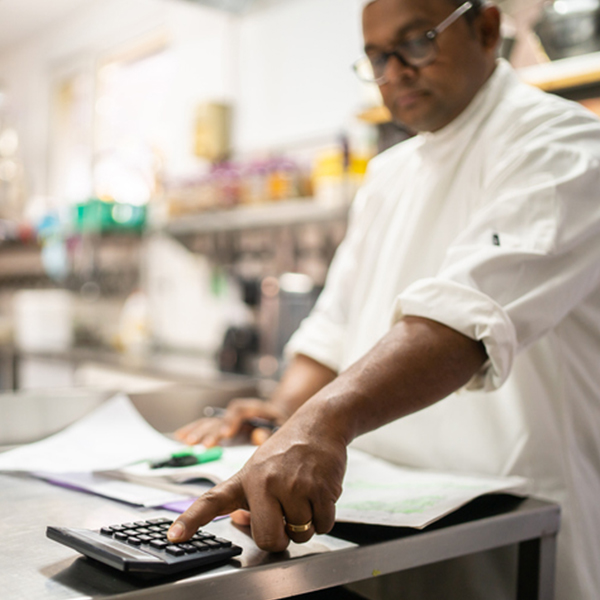
Chef using calculator in a kitchen (Vladimir Vladimirov, Getty Images)
Learn about how math is used in the kitchen.
Do you like to cook or bake? Have you ever wanted to make something and realized you didn’t have the right measuring cup? Did you use a smaller measuring cup instead? If you did, you were using math! Math functions like conversions, fractions and time calculations are all important for cooking. Everybody who cooks, from home cooks to world famous chefs, use math in the kitchen!
The Scoop on Measurement and Conversion
Measuring
Measuring is an important part of cooking and baking! Have you ever come across a vintage recipe asking for a 'tumbler' of milk or a 'gill' of sugar? Did you wonder what they were talking about? Fear not! Today, we have precise measurements at our fingertips, making cooking much more straightforward and enjoyable!
Did you know that wet and dry ingredients require different kinds of measuring cups?
For liquids, like milk or oil, you'll want to use a wet measuring cup. These are designed to allow the ingredient to self-level, so you can fill it to just below the measurement marked on the outside.
For dry ingredients like flour or sugar and even mayonnaise, try to use dry measuring cups. These are meant to be filled right to the top. Then you can use a knife to level it off precisely.
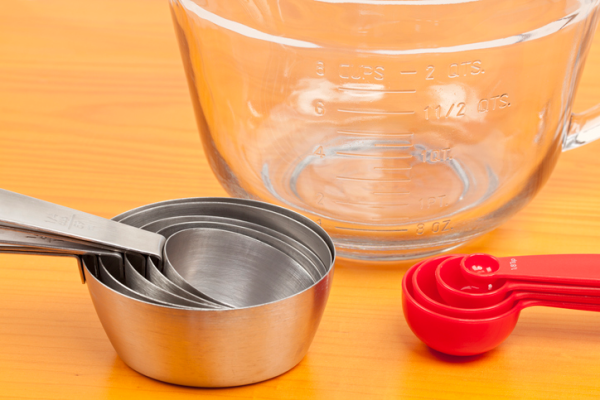
Image - Text Version
Shown is a colour photograph of a liquid measuring cup, dry measuring cups and measuring spoons, on a wooden table. The liquid cup is large and clear glass, with a handle and spout. Measurements in cups and quarts are marked on the outside. In front, on the left, the dry measuring cups are silver metal. They are piled so that each size nests inside the one larger. To the right, a set of red measuring spoons are piled in a similar way.
In kitchens in North America, many people use the Imperial System of measurement when cooking. These measurements are not used in the Metric System.
| Measurement | Unit | Abbreviation |
|---|---|---|
| Weight | Pound Ounce |
lb. oz. |
| Volume | Gallon Quart Pint Cup Fluid ounce Tablespoon Teaspoon |
gal. qt. pt. c. fl. oz. or oz. tbsp. tsp. |
Conversion
To use some recipes, you may need to convert from one type of measurement to another. Like from tablespoons to teaspoons or from ounces to cups.
To convert from teaspoons to tablespoons you need to divide by three.
1 tbsp. = 3 tsp.
1 tsp. = ⅓ tbsp.
To convert from cups to tablespoons you need to divide by 16.
1 cup = 16 tbsp.
1 tbsp. = 1/16 cup
To convert from cups to fluid ounces , you need to divide by eight.
1 cup = 8 fl. oz.
1 fl. oz. = ⅛ cup
Question 1:
How many teaspoons are in one cup?
The Scoop on Accuracy and Precision
If you do a lot in the kitchen, do you prefer cooking or baking more? There could be many reasons for this, but one of them might be math! Cooking requires people to be precise, but baking requires people to be accurate. You may think those two words mean the same thing, but they do not!
Accuracy is all about how close your measurement is to the true value. Some measuring tools are better for this than others. For instance, consider measuring flour with a cup versus a digital scale. The scale gives a more accurate measurement.
Precision is about how close your measurements are to each other. Imagine you and a friend both wanted to cook chili. The more precise you both are with your measuring, the more similar your chili will taste.
Accuracy & Precision Hint
Accuracy = Close to Correct
Precision = Repeatable
Ultimately, baking is like conducting an experiment! The chemical reactions that happen between ingredients—like baking soda and vinegar—require exact proportions. If you don’t follow a baking recipe accurately, you can get unexpected results and treats that don’t taste great! For example, too much baking soda can cause a cake to rise too quickly, then collapse.
In cooking, accuracy is not always as critical. There's more room for flexibility. A cook can adjust ingredients according to their taste, adding a bit more or less without significantly altering the final result. But if they want to repeat the dish, they will need to record what they did!
The Scoop on Fractions and Ratios
Fractions
A cup can be divided into smaller parts, known as fractions. Imagine a cup as a whole, and then think about splitting it into equal parts. For example, if we divide a cup into two equal parts, each part is called a half-cup. This means that two half-cups together make one whole cup.

Image - Text Version
Shown is a colour photograph of liquid measuring cup marked in fractions of a cup and in milliliters. The cup is clear glass with a handle and spout. The measurements are printed in red. Starting at the top, it is marked “1 cup, ¾, ½ cup and ¼.”
If we divide each half-cup into even smaller parts, we get more precise measurements called quarter-cups. We can also divide a whole cup into thirds, which means each part is one-third of a cup. This is particularly useful for recipes that call for specific, accurate amounts of ingredients.This level of precision is very handy, especially in baking where it can make a big difference.
Sometimes we measure without cups. How do we do it? Think of something that is yellow, comes in a rectangular package and tastes delicious on popcorn. What is it? Butter! Some butter packages have measurement guides. This is great for baking.
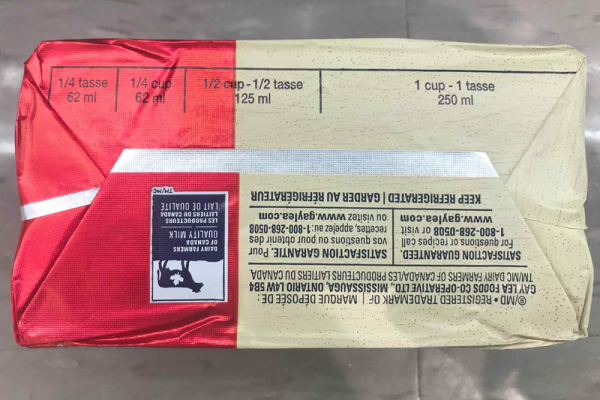
Image - Text Version
Shown is a colour photograph of a butter wrapper. The package is red and beige, folded around a rectangular block with uneven edges. The top of the long side has a black line divided into sections representing cups. Starting on the left, there are two ¼ cup sections, one ½ cup section, and one 1 cup section.
Individually wrapped sticks of butter are another convenient form of measurement. Each stick contains ½ cup or eight tablespoons of butter. Cutting a stick in half gives you ¼ cup or four tablespoons. When you combine four sticks to form a block, you have a total of two cups of butter.
Try this!
Say you have a cake that you want to cut into eight equal slices but you can only cut the cake three times. How do you cut it?
Scroll to the end for the answer!
Ratios
Ratios come into play when adjusting recipe quantities. For example, when you double a recipe, you need to keep the same ratio of ingredients to each other. This ensures the dish has the same taste and consistency, even though it’s bigger!
Imagine you have a recipe that serves four people. But you want to serve eight people. You would need to double the number of ingredients. Say the original recipe calls for one cup of flour and two cups of water. We could show this as a ratio. One cup of flour: two cups of water, or 1:2.
If we double this, then we need to multiply both sides of the ratio by two.
2(1): 2(2)
This would give us the ratio of 2:4. So you would need two cups of flour and four cups of water. This maintains the balance of ingredients, while scaling up the amounts. So the dish turns out as you’d expect! In this case, the ratio does not change. The doubled recipe still has a ratio of one part flour to two parts water, or 1:2.
Ratios are also a great shortcut for experienced cooks. They are a simple way to remember some basic recipes! Here are some common examples:
- Salad dressing is 3 parts oil to 1 part vinegar (3:1)
- Bread dough is 5 parts flour to 3 parts liquid (5:3)
- Pie crust is 3 parts flour to 2 parts fat, like butter or shortening to 1 part water (3:2:1)
So, you could make an enormous pie, or a tiny bit of salad dressing, as long as you use the right ratio of ingredients!
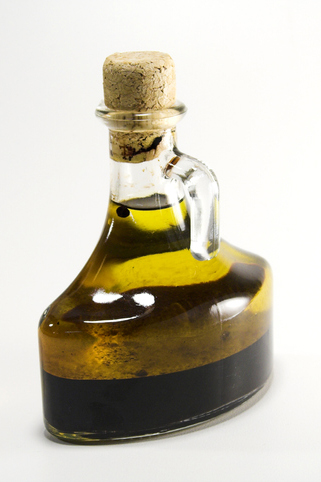
Image - Text Version
Shown is a colour photograph of a glass bottle filled with two different liquids. The top two thirds of the bottle are filled with a translucent, olive green liquid. The bottom third is filled with a dark brown liquid. The two parts are separate, but a few dark bubbles of dark liquid rise up into the lighter one. The bottle is oval-shaped with a narrow neck, a small handle and a cork in the top.
Once you have mastered a basic recipe, you can build on it to suit your taste. For some people, that might be adding cheddar cheese to bread. Or adding spices to a salad dressing. But this can take some trial and error. Certain recipes are harder to modify than others.
Question 2:
How much flour and water would you need to make a pie if you only had 1 cup of butter?
Temperature and Time
Temperature and time are really important when baking. They affect how recipes turn out. Different recipes need different temperatures for specific reasons. For example, both muffins and bread need to be baked at a high temperature. This makes them rise faster and develop the golden crust we love.
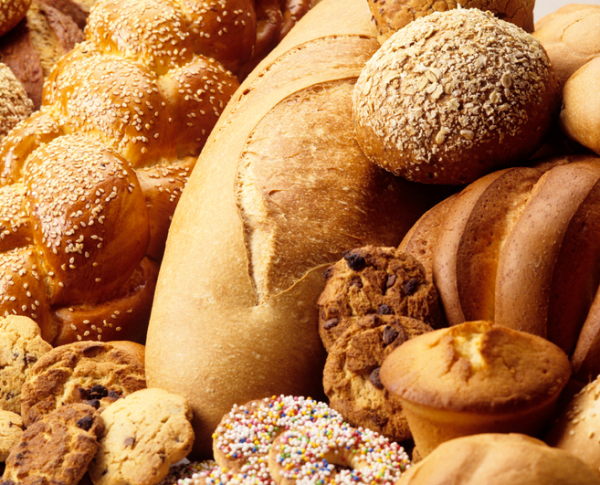
Image - Text Version
Shown is a colour photograph filled with breads, buns, muffins and cookies. The items are all different shades of gold and light brown. Some are sprinkled with seeds, flour or cake sprinkles. Others are embedded with chocolate chips or raisins.
Temperatures, like measurements, rely on different scales. The two scales people use when cooking and baking are Fahrenheit (°F) and Celsius (°C). In baking, Fahrenheit is most common. But there may be times when you need to convert between the two. To convert a temperature, follow these steps:
- °C to °F Divide by 5, then multiply by 9, then add 32
- °F to °C Deduct 32, then multiply by 5, then divide by 9
Imagine you're baking a cake, and the recipe recommends a temperature of 180°C, but your oven measures in Fahrenheit. Let's use the conversion to find out what to set the oven to.
°F = (°C/5 x 9) + 32
Plugging in 180 for °C:
°F = (180/5 x 9) + 32
°F = (36 x 9) + 32
°F = 324 + 32
°F = 356
So, 180 degrees Celsius is approximately 356 degrees Fahrenheit.
Question 3:
What is 662° Fahrenheit in Celsius?
The relationship between cooking time and temperature is very important. If you use a higher temperature, your food will be cooked faster. But this could change its texture and moisture. Lower temperatures and longer times result in gradual, even cooking. This impacts the flavour and tenderness of the food.
The temperature of ingredients before cooking can also affect a recipe. For example, many cake recipes call for room temperature butter or eggs, rather than cold from the refrigerator. And people often cook steaks from room temperature to give them more flavour.
Temperature is also important in food! People who cook meat can use meat thermometers to measure its precise internal temperature. This ensures it has been cooked to the correct temperature and is safe to eat. Undercooked meat can contain bacteria that may cause food poisoning.
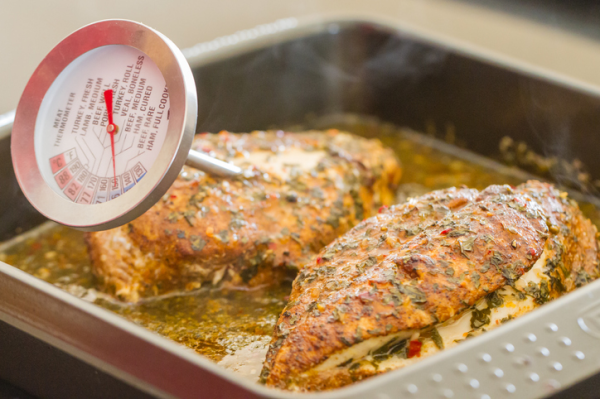
Image - Text Version
Shown is a colour photograph of two chicken breasts in a pan. The top breast is pierced with a metal thermometer. The dial on top reaches about a third of the way up the scale, but the numbers and markings are too small to read. The meat is steaming and looks moist. It is golden brown on the outside and coated with green and red flakes.
Data Anyone?
Did you know that collecting and analyzing data is an important part of cooking? Records of recipes you’ve cooked and adjustments you’ve made are forms of data. This data can be stored on recipe cards and shared with others!
Also, by taking note of the flavours, textures and cooking methods, you can pinpoint areas for improvement in recipes.
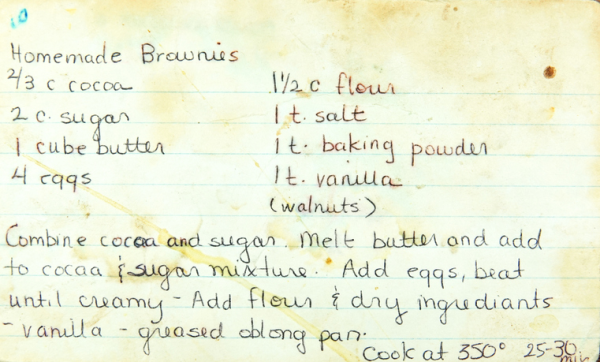
Image - Text Version
Shown is a colour photograph of a card marked with food stains and fingerprints. The recipe is written with black ballpoint pen. It is titled “Homemade Brownies.” The recipe reads “⅔ c. cocoa, 2 c. sugar, 1 cube butter, 4 eggs, 1 ½ c. flour, 1 t. salt, 1 t. baking powder, 1 t. vanilla (walnuts). Combine cocoa and sugar. Melt butter and add to cocoa & sugar mixture. Add eggs, beat until creamy. Add flour and dry ingredients - vanilla - greased oblong pan. Cook at 350°, 25-30 min.”
Commercialized food operations, like cereal companies, collect data on a larger scale. They do this through different rounds of product testing. Real people try the food and the company gathers data about what they think. By applying statistical techniques to the data, companies are able to determine if their product will be successful or not.
Did you know?
People who taste test food for a living are not called “taste testers”. Their official job title is Sensory Evaluator! They do more than just taste, they analyze the texture, flavour and smell of food. It’s about the whole experience of consuming a product.
The kitchen is a great place to grow and develop mathematical understanding. Measuring ingredients, temperature and time are key skills that allow a cook to feel confident. Fractions and ratios are powerful tools for home and professional cooks! Understanding accuracy and precision helps a cook create dishes that taste just right.
As we explore data and statistics, we realize how these ideas reach far beyond the kitchen, impacting even the biggest food companies. By carefully gathering and analyzing data, they refine products to suit the varied preferences of their customers.
So, when you're in the kitchen, remember, math can help you be a better cook!
Answers
Q1: How many teaspoons are in one cup?
There 3 tsp. in 1 tbsp. and 16 tbsp. in 1 cup. So there are 3 x 16 = 48 tsp. in 1 cup.
Q2: How much flour and water would you need to make a pie if you only had 1 cup of butter?
Pie crust is 3 parts flour to 2 parts butter or shortening to 1 part water. The ratio is 3:2:1 If you had two cups of butter, you wouldn’t have to do much math! Just add three cups of flour and one cup of water. But if you only had one cup of butter, then you would have to divide every other part of the ratio in two as well.
3/2: 2/2: 1/2. This gives us 1.5:1:0.5.
So, you would need 1 ½ cups of flour and a ½ cup of water.
Q3: What is 662° Fahrenheit in Celsius?
To go from °F to °C you deduct 32, then multiply by 5, then divide by 9
= [(662-32) x 5]/9
= (630 x5)/9
= 3 150/9
= 350
662° Fahrenheit is 350° Celsius
Try This Answer:
You make two cuts across the top and one cut through the middle of the cake!
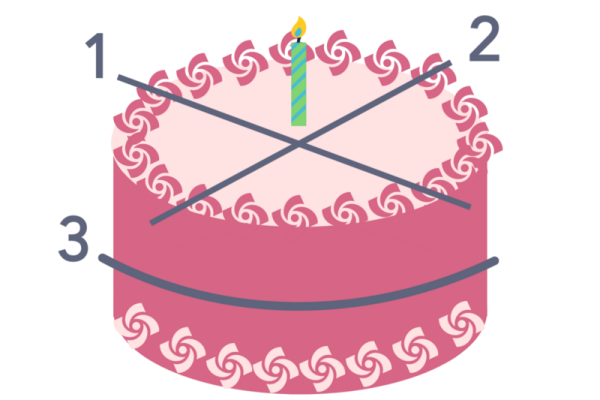
Image - Text Version
Shown is a colour illustration of a cake divided by lines marked 1, 2 and 3. The cake is tall and round with pink icing and one candle. A grey line marked 1 stretches diagonally across the top of the cake, from top left to bottom right. A grey line marked 2 stretches from the top right to the bottom left. Below, a grey line marked 3 curves horizontally across the circumference of the cake
Learn More
Ratios for recipes (2017)
This video (4:50 mins) from Khan Academy explores ratios used for easy and consistent recipe conversions.
Tuesday Tip: Ounces Vs. FL Ounces (2021)
This video (2:50 mins) from Chef Brenda, RDN explains the difference between weight ounces and fluid ounces.
How to Measure Wet and Dry Ingredients - Kitchen Conundrums with Thomas Joseph (2015)
This video (4:35 mins) from Everyday Food breaks down the basics of measuring. This includes looking at the difference between wet and dry ingredients and how to be accurate.
Culinary Calculations | Online Math Toolbox Ontario (2017)
This video (2:43 mins) from Parent Engagement Matters gives a glimpse on how a real cook uses math to cook for a large number of people everyday.
Artichokes and Fibonacci Sequences (2020)
This video (5:50 mins) from Aj Alaniz looks at the Fibonacci Sequence and how an artichoke can be used to better understand it.
References
Alan, H. (2021, January 25). Free Yourself from Recipes With a Few Golden Cooking Ratios. LifeHacker.
BC Cook Articulation Committee. (n.d.). Basic Kitchen and Food Service Management. Open Text BC.
Math is Fun. (n.d.). Conversion of Temperature.
Pierce, Rod. (2022, June 20). Conversion of Temperature - Celsius to Fahrenheit. Math Is Fun.
The Culinary Pro. (n.d.) Culinary Math. Culinary Math, Science & Ratios.